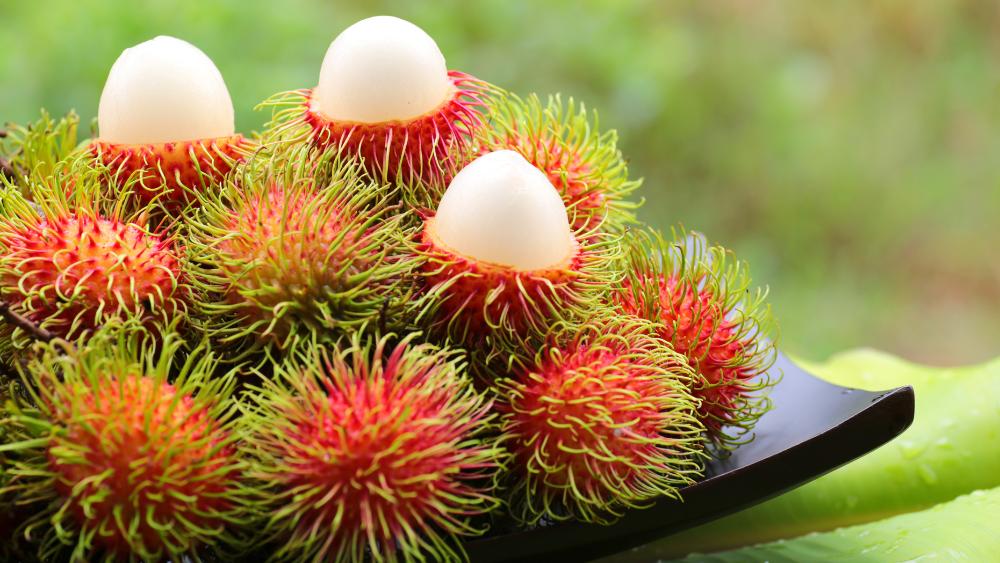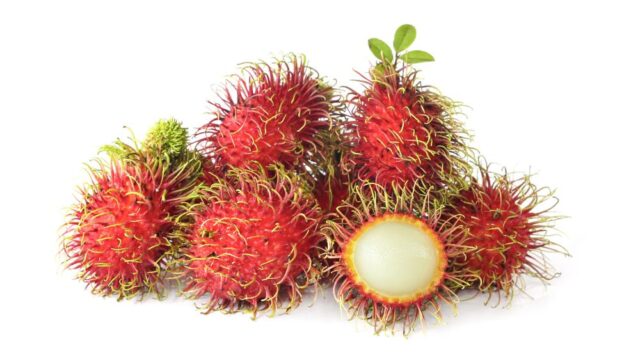
What is the Rambutan? A red, hairy and exotic fruit not so well known worldwide that is full of properties, benefits and is delicious. A oxymoron? A joke we came up with Day of the Innocents? No! This is absolutely true.
They say that those who try it are delighted, so we are not only going to encourage them to try it but we are also going to ask them to tell us what they thought of it. In case you are not convinced, below we will tell you even the smallest detail about the rambutan.
All about rambutan
What is this curious fruit?
This is an exotic tropical fruit that awakens the curiosity and palate of those who venture to try it. The most notable feature of this fruit is its outer skin, which is covered in small, soft, pointed hairs.
This texture has earned it its name, derived from the Malay word “hair“, which means hair. The skin, a vibrant red or yellow, surrounds a juicy, translucent pulp in shades of white or pink. It may look intimidating due to its exotic appearance, but its interior is rewarded with a sweet and refreshing flavor.
To give you an idea, this is similar to the lychee in terms of flavor and texture. Its pulp is sweet and refreshing, with a slight bittersweet touch. Many people describe its flavor as a mix between grapes and lychees, which makes it a delicious option to satisfy cravings for tropical fruits, which also include cherimoya and pitaya.
Goodness and benefits of rambutan
The versatility of rambutan It is in its culinary use. It can be enjoyed fresh or incorporated into fruit salad, prepared desserts, sugar-free fruit pie, and beverages such as smoothies and tropical cocktails.
Its unique flavor and texture make it a versatile ingredient in the kitchen, and its attractive appearance makes it a decorative element on elegant dishes.
This is much more than an exotic fruit with soft, spiky hairs on its skin. It captivates the senses and enriches the culinary experience of those who savor it.
Rambutan and its place in the world
As the demand for exotic fruits grows, this product has found a place in different parts of the world with tropical climates conducive to its cultivation. In Mexico, for example, it has been established in areas such as Chiapas, Veracruz, Tabasco and Quintana Roo.
These regions, with their warm and humid climate, provide the right environment for fruit to grow and develop. The cultivation in Mexico not only satisfies the local demand for exotic fruitsbut also contributes to the local economy and employment in these areas.
Furthermore, the rambutan Mexican adds to the diversity of fruit options available in the country, enriching people’s diets and offering a unique taste experience.
Follow me on Instagram (here)
And on YouTube I upload new videos every week (click here)
10 peculiarities about rambutan
- Origin and Diffusion: It is believed that this fruit it could have originated in the region of Malaysia and Indonesia. Over the years, it has been brought and cultivated in various parts of the tropical world, including Latin America and Africa, for its ability to adapt to climates similar to its habitat of origin.
- Scientific name: Rambutan’s scientific name, “Nephelium lappaceum,” comes from the Greek term “nephele,” meaning “cloud,” due to the appearance of the clusters of fruits hanging from the trees. “Lappaceum” refers to the Latin name of the fruit.
- Varieties: Although the most common variety of rambutan has a red or yellow skin, there are also varieties with green skin. These varieties may offer slight differences in flavor and texture.
- Cultivation and Pollination: Rambutan is an evergreen tree that can grow up to 20 meters tall in well-drained, moist soil. Pollination of rambutan is carried out mainly by bees and other insects.
- Traditional Use: In addition to its fresh consumption, in some regions where rambutan is grown, it is used in traditional medicine because it is believed to have multiple benefits in treating health problems.
- Harvest Season: Rambutan harvest season can vary by region and climate, but generally falls during the warmest months of the year.
- Skin Preparation: Peeling the skin of rambutan can be a challenge due to the small hairs. Some people suggest soaking the fruit in hot water for a few minutes before peeling it to make the process easier.
- Culinary Combinations: In some places, rambutan is combined with other ingredients in unique dishes. For example, in Thailand, it can be found in spicy salads along with other intense flavors.
- Events and Festivals: In some regions festivals and events dedicated to this fruit are often held. They include tasting competitions, peeling contests and rambutan-related activities.
- Sustainability: Rambutan, like other fruits, can play a role in agricultural sustainability. By growing and consuming these tropical fruits locally, you can reduce the environmental footprint associated with long-distance food transportation.

Source: www.paulinacocina.net


